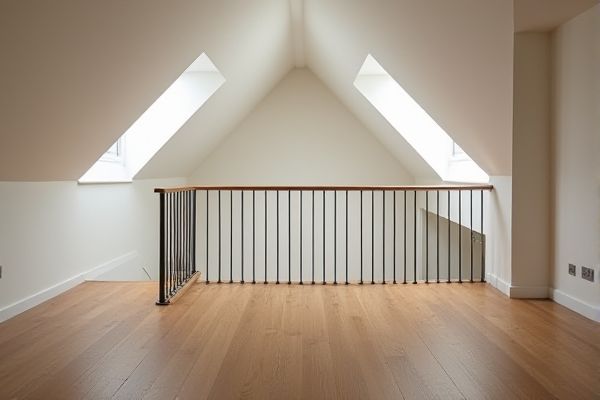
An attic open railing creates a spacious, airy feel by allowing unobstructed views and natural light flow, while a half wall offers more privacy and structural support without fully closing off the space. Explore the rest of the article to determine which option best suits your attic renovation needs.
Table of Comparison
| Feature | Attic Open Railing | Half Wall |
|---|---|---|
| Visibility | Provides clear sightlines, open feel | Partially blocks view, more privacy |
| Safety | Requires sturdy balusters, less safe for children | Offers better safety, solid barrier |
| Light Flow | Maximizes natural light penetration | Reduces light flow slightly |
| Sound Control | Minimal sound blocking | Improves sound separation |
| Design Style | Modern, airy, minimalistic | More traditional, solid appearance |
| Installation Cost | Moderate to high, depending on materials | Moderate, generally less complex |
| Maintenance | Requires regular cleaning of balusters | Easy to clean and maintain |
Introduction to Attic Open Railing vs Half Wall
Attic open railings create a spacious, airy feel by allowing unobstructed views and maximizing natural light, enhancing your attic's aesthetic appeal. Half walls provide a sense of privacy and defined space while maintaining an open layout, offering safety without completely closing off the area. Choosing between open railings and half walls depends on your attic's design goals and functional needs.
Key Differences Between Open Railing and Half Wall
Open railing in attics creates a visually spacious environment by using vertical balusters or spindles that maintain sightlines, while a half wall provides a more solid barrier offering enhanced privacy and structural support. Open railings emphasize openness and light flow, ideal for architectural aesthetics and safety without obstructing views, whereas half walls serve as partial enclosures that can be integrated with storage or seating options. Your choice depends on balancing openness with functionality, considering safety, design preferences, and the attic's overall use.
Safety Considerations for Attic Railings and Half Walls
Attic open railings provide clear visibility and a spacious feel but require sturdy balusters spaced according to local building codes to prevent falls, especially for children and pets. Half walls offer a more solid barrier, reducing the risk of accidental falls while still allowing light and air flow; however, they must be constructed with adequate height and strength to meet safety standards. Proper installation and adherence to regulations such as the International Residential Code (IRC) ensure both open railings and half walls effectively safeguard attic spaces.
Aesthetic Appeal: Open Railings vs Half Walls
Open railings in attics create a spacious, airy atmosphere that enhances natural light flow and modern design aesthetics. Half walls offer a cozier, more defined space while providing additional privacy and surface area for decor or storage. Your choice depends on whether you prioritize openness and light or separation and functionality in your attic design.
Space and Light: Maximizing Attic Airiness
An attic open railing enhances space and light by allowing unobstructed natural light to flow freely, creating an airy and open atmosphere. Half walls can limit light penetration and visually divide the space, making the attic feel smaller and more enclosed. Your choice between these options will directly impact the attic's overall brightness and spaciousness.
Privacy Factors: Which Option Offers More Seclusion?
Attic half walls provide greater privacy by creating a solid barrier that blocks both sight and sound, enhancing seclusion in your space. Open railings allow for more visibility and airflow but offer minimal noise reduction and limited privacy. Choosing half walls over open railings is ideal if your priority is a secluded, private attic area.
Installation and Cost Comparison
Open railing installation in attics typically requires precise measurements and skilled labor to ensure safety and compliance with building codes, often increasing labor costs. Half walls involve framing and drywall work that may add to material expenses but can be easier for DIY installation compared to intricate railing systems. Your choice between open railing and half wall impacts overall cost depending on materials, labor complexity, and desired aesthetic in attic renovations.
Maintenance Requirements for Each Option
Attic open railings require regular cleaning and periodic inspections to ensure the balusters and handrails remain securely fastened and free of damage, making upkeep relatively straightforward but essential for safety. Half walls demand routine dusting and occasional repainting or drywall repair due to their larger surface area and potential for scuff marks, resulting in moderate maintenance needs. Your choice impacts how often you perform these tasks, with open railings favoring simpler maintenance and half walls requiring more frequent surface care.
Resale Value Impact: Railing vs Half Wall
Open railing in attics creates a spacious, modern appearance that often appeals to buyers, potentially increasing resale value by enhancing natural light and visual flow. Half walls provide a sense of separation and added privacy but may reduce the perception of openness, possibly limiting buyer appeal in markets favoring open concepts. Real estate trends indicate that open railings can lead to higher resale values in urban and contemporary homes, while half walls might suit traditional settings with minimal impact on price.
Choosing the Best Option for Your Attic Renovation
When choosing between an open railing and a half wall for your attic renovation, consider factors like safety, aesthetics, and natural light flow. Open railings create a spacious, airy feel while maximizing light and visibility, ideal for modern designs and smaller spaces. Half walls offer more privacy and a sense of separation, making them suitable for creating cozy, defined areas without completely closing off the attic.
 homyna.com
homyna.com